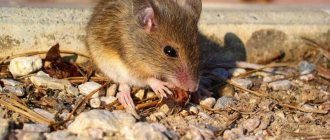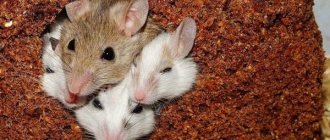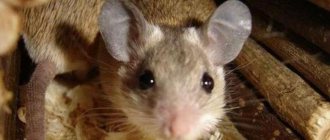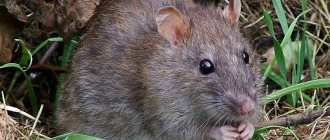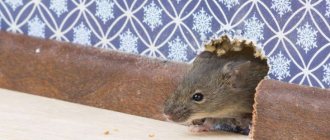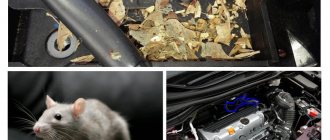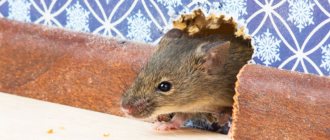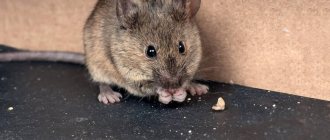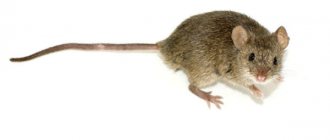Rodents appear in a house regardless of what material it is built from. Brick, concrete or wooden walls do not equally protect a building from the penetration of a small gray mouse or a larger pest. They are able to get into a narrow gap between structures, through passages dug in the ground, run into an uncovered door, crawl through communication pipes. Warmth and available food attract animals into housing, especially in late autumn. Feeling the approach of cold weather, they look for a reliable shelter for the winter. The most effective way to keep pests out of your home is with physical barriers. A metal mesh against rodents will create a barrier and prevent the presence of unwanted guests in a frame house.
sells galvanized mesh to protect against mice and rats. No “rods”, “strings” or joints, just a solid sheet!
OC mesh 6x6 for 149 rubles/sq.m., roll size 1x10m, OC mesh 10x10 for 107 rubles/sq.m., roll size 1x15m.
The warehouse store is located at: Moscow, st. Remizova 14k1 (m. Nagornaya) Delivery and pickup available! We take away unspent surpluses!
Phone Website: https://setkamsk.ru
Where do mice go?
Due to the peculiarities of its construction, a frame house is an attractive place for a rodent to stay. A wooden or, less commonly, metal frame made of racks, support beams, and struts is sheathed on the outside and inside with protective and finishing materials. Slab insulation is laid inside the hollow walls. Floors are often arranged on joists, between which thermal insulation is placed in the form of rolls or slabs.
The technology involves installing ventilation gaps to remove condensate and circulate air in structures. This protects them from rotting and moisture accumulation.
At the same time, all cracks and technological gaps are an accessible route for mice to enter. Favorite habitat is insulation slabs. Rodents make passages in them, make nests, and breed numerous offspring.
Mouse fuss is annoying, but in addition to this, considerable damage is caused to the insulation. The structure loosens and disintegrates over time, which leads to loss of heat-insulating properties.
Research conducted in the USA at the University of Fisheries, Forestry and Wildlife Sciences found that over six months of rodent activity, the thermal conductivity of insulation increases 5 times.
The experiment involved families of house mice. They were planted for 6 months in imitation walls, insulated with common types of insulators for frame, brick and concrete houses - extruded polystyrene foam, basalt or glass wool, vermiculite, cellulose ecowool. Foil vapor barriers and isocyanate did not stop the sharp teeth.
Being near mice is dangerous for electrical wiring. Violation of the insulation from the sharp teeth of rodents can lead to a short circuit and even a fire.
Wooden structures - frame elements, floors, ceilings - are thoroughly damaged by gray animals. These are undesirable phenomena that lead to a gradual loss of strength and disruption of the aesthetic appearance of the finish.
A bit lukewarm
When building frame houses, plastic is often used as insulation, as it has low cost and excellent thermal insulation characteristics. But it is this choice that often leads to the appearance of mice in the house. The fact is that plastic is an excellent place for mouse nests to appear.
Fortunately, this problem can be solved very simply. It is enough to make a choice in favor of a tepid one. Of course, unlike plastic, installing lukewarm panels will require more time and special skills, but the resulting result will pay off all the costs and difficulties.
Formidable enemies
House mice are the largest population of mammals. They reach a length of 9.5 cm and a weight of 30 g. Thanks to the property of synanthropy - coexistence with humans - they are perfectly adapted to his lifestyle and housing. They live everywhere except in the Far North and Antarctica.
A little mouse can run 5 km in search of suitable housing. She is especially active at the end of summer and autumn, as she really does not like cold weather. It digs holes in the ground to a depth of 60 cm. It moves along constant routes, leaving paths of dust and droppings, holding them together with urine. Its specific smell indicates the existence of a rodent in the room.
Mice live in families where there are several females per dominant male. The individual range around the nest is 900-1200 m². Rodents try not to leave the area.
House mice run fast, climb, jump, and swim well.
They breed all year round. One female can bring up to 120 cubs per year.
The centuries-old proximity of mice and humans is an indisputable fact. But the fact that 80% of the rodent genome is the same as the human genome still remains a mystery. This feature is used in science to study diseases and methods of treating them. The Methuselah Foundation, which deals with the problem of aging, awarded a prize in 2005 for the five-year longevity record of a laboratory mouse. A monument was erected to her in Novosibirsk Akademgorodok.
The house mouse's closest "companions" are gray and black synanthropic rats. Their lifestyle is similar to that of mice, but the damage caused to the farm is many times greater. Rodents, without any harm to their own health, damage lead and aluminum pipes and live cables, creating emergency situations in transport and communication networks.
A feature of a large rodent is the ability to adapt to poisons and the ability to think abstractly. Thanks to this, the pest population is constantly growing, despite active control - deratization.
Why are rodents dangerous?
Not only building structures, but also food supplies suffer from mice and rats. Having made their way into storage, animals are able to quickly destroy or contaminate cereals, vegetables, and fruits. They do not neglect anything, even soap, candles and glue, although they belong to the rodent species. In nature, the basis of their diet is plant seeds.
Clothes, shoes, books, furniture when they “meet” with mice become unsuitable for further use.
Being around rodents is dangerous for humans. Mice and rats carry severe, even fatal infections - pseudotuberculosis, plague, leptospirosis, tularemia. Infection occurs through contact with feces or the bite of blood-sucking arthropods that live on animals and easily pass to humans.
Recent studies have confirmed that the virus that causes tumors in the mammary glands of mice is contagious to humans and contributes to the development of breast cancer.
Ultrasound sources
Modern methods include ultrasound generators, which repel rodents during operation. It is worth saying that such devices have a controversial reputation, since the Internet knows many stories about how rodents calmly walked next to a working ultrasound generator and did not pay any attention to it.
For the most part, this is due to low-quality ultrasonic generators that have flooded the domestic market. Therefore, if you still decide to buy such a device, be sure to choose a high-quality model from a brand with a good reputation.
Note! Ultrasonic generators affect not only rodents, but also pets. Therefore, these two methods do not combine well with each other.
Metal mesh – barrier for rodents
In order to encounter mice and rats on your territory as rarely as possible, you need to make your home inaccessible to penetration from the outside. Protection of frame houses from rodents is carried out comprehensively - from the construction of the foundation to the extermination of pests when they appear.
To prevent mice from entering the house, galvanized metal mesh with a mesh size of up to 6 mm is used. This size is due to the ability of the animal’s skull to flatten to a minimum volume. Plastic protection is not reliable; rodents can easily deal with it.
Expanded metal mesh is ideal for this purpose. Even small rodents will not be able to squeeze through the small hole. They are made from sheet metal 0.45-0.50 mm thick by cutting diamond-shaped cells and then stretching them. The product is called abbreviated as TsPVS - all-metal expanded metal mesh.
The main application is reinforcing putties and plasters, but recently it has been widely used as protection of frame houses from mice and rats. CPVS weighs little and does not spread when deformed. It is durable, not susceptible to corrosion and the effects of sharp rodent teeth.
The mesh is attached directly to the frame with staples using a construction stapler or self-tapping screws with press washers. For installation on thermal insulation, special elongated clamps are used.
The price of the material is affordable - 70-160 rubles/m². The investment pays off with a restful sleep, saved nerves and money.
In addition to TsPVS, woven meshes with a mesh size of up to 6 mm and a wire thickness of 1.2 mm are used. They are more expensive - up to 250 rubles / m², but more powerful metal can stop not only mice, but also rats.
Rodents can go deep into the ground up to 50-60 cm. They enter the house through cracks in the foundation, basement and floors, so the main protection should be located at the level of these structures.
Professionals who have built dozens of frame houses advise how to protect a frame house from rodents using a mesh:
- Secure a vertical underground curtain around the perimeter along the base and foundation to a depth of at least 100 cm;
- Lay it on the subfloor with a layer preceding the insulation so that mice cannot get into it and settle in;
- Trim the outer corners of the building before finishing;
- Close ventilation gaps, chimneys, foundation vents and other technological openings.
Potential entry points for rodents will be covered with a barrier that is impenetrable to rodents. The main requirements for the mesh are cell size - up to 6 mm and sufficient thickness of the zinc layer. A mouse will fit into larger holes without difficulty, and poor quality galvanization will lead to rapid destruction of the base metal.
Features and purpose
The mouse net should be made of small diameter wire. The canvas is sold in rolls or sheets 1–2 m wide and 6–15 m long.
Network Applications:
- installation of fences, barriers;
- plastered surfaces;
- creation of a reinforcing belt;
- strengthen the foundation;
- for the construction of monolithic structures;
- when screeding.
Attention! To protect your home from rodents, you need to choose a mesh with a wire diameter of more than 0.4 mm. Otherwise, he will not be able to resist the invasion of uninvited guests.
Reliable methods for rodent control
If mice appear in the house, you can use traditional methods - poisoned baits, tobacco dust, mint, mousetraps, or more modern ones - ultrasonic repellers. But the most effective way is to prevent pest entry by installing protection during the construction phase.
Reinforced concrete slab
A monolithic foundation made of reinforced concrete is a strong foundation for the building and an insurmountable obstacle to the teeth of rodents. Mice and rats will not be able to penetrate a reinforced slab 25-30 cm thick. The remaining paths can be protected with fine mesh.
Expanded clay
A subfloor laid on the ground can be made impenetrable to rats and mice using expanded clay.
Expanded clay is poured onto the prepared base in a layer of 25-45 cm. A layer of lean concrete 3-5 cm thick is laid on top or poured with cement mortar. Then a dense waterproofing film or membrane is spread. The installation of floors is completed with screed, gypsum fiber or particle boards, and finishing.
Expanded clay is inedible for mice.
They do not make passages in it or make nests. They will not be able to settle in the insulation due to its friability.
Insulation
When choosing a heat insulator for a frame house, such a characteristic as damage by rodents is important. There are three categories of insulation materials, to which mice have different attitudes.
They never touch the first ones. This is foam glass in granules and slabs, glass wool, ecowool. Materials based on silicate raw materials injure the mucous membranes of the mouth. A thin layer of glass wool is enough to stop the rodent. Borax and boric acid, which are used to treat cellulose, are toxic to them. Therefore, the walls of frame houses can be insulated with these heat insulators without fear.
The second category is reluctant to be damaged by mice. These are basalt wool, extruded polystyrene foam, liquid expanding polyurethane foam. The materials are inedible to animal pests, but are permeable. They make passages through them and use fibers to make nests.
The third type of insulation is the most beloved and inhabited by rodents. This includes polystyrene foam and expanded polystyrene. In light, warm materials, gray pests create extensive labyrinths and nests in which they hatch numerous young.
To prevent uninvited tenants from settling in a frame house, high-quality, high-density materials are chosen for insulation.
The tougher they are, the less they attract rodents.
Metal bumpers
Used to protect against mice in houses on pile or strip foundations. They are circular ebbs installed around the perimeter of the building at the level of the top of the plinth. Their width is at least 36 cm.
A continuous strip of smooth metal 40-45 cm high will become an obstacle to rodents climbing the walls.
Some builders recommend mounting the base for the subfloor of a frame house on a pile foundation from sheets of steel, for example, corrugated sheets. This is a reliable way to prevent animals from entering your home.
Fighting methods
If mice do find their way into your home, you need to know how to get rid of them. There are many methods. The main thing is to choose the appropriate method, taking into account the type of structure and the number of pests.
Some people use poison, however, this is one of the worst methods because the mouse can die in the wall. You can only get it if you destroy the wall. The cadaverous smell will spread throughout the house, after which it will simply be impossible to stay in it. Even products that have a mummified effect leave an unpleasant odor, although less strong. In this regard, it is recommended to drive away mice or catch them.
Traditional methods
The following methods can be used by builders during the construction of a building or by residents after the construction process is completed. So, the techniques are as follows:
- To scare away, burnt logs are placed under the floor.
- Along with the insulation, tobacco dust, ash, chamomile, wormwood, mint, slag, dry burdock, and pine branches are added.
- Red hot pepper powder is sprinkled along the walls.
- Broken glass is placed under the floor.
These methods are the most popular, but there are others.
Useful: Reviews about frame houses
Mechanical means
Mousetraps, snares, and snares are often used to control rodents. It is better to place them along the walls in rooms where the mouse was noticed. At the same time, it is also necessary to seal the holes and cracks through which pests entered the home, otherwise new individuals will appear every time. You can buy such devices, or you can make them yourself. Let's look at some methods of preparing them.
Option 1. Cut off the neck of a plastic bottle, put bait inside and coat the walls with sunflower oil. Next, you need to lower the neck into the middle of the bottle and secure it with tape. A mouse can easily climb into such a trap, but due to the slippery walls it will no longer be able to get out of the bottle.
Option 2. Pour water into a bucket, place husks, leaves or straw on top, pour 1 spoon of vegetable oil, sprinkle grains or seeds. So that the mouse can easily climb, you need to install a ladder. It can be an ordinary stick. When the rodent tries to get food, it will fall into the water and drown. The top layer will fall into place, so more than one pest can get caught in the trap.
Option 3. You can use oilcloth, plywood or thick cardboard to form an adhesive trap. Attach this base to the floor, pour glue on top and place the bait in the center. The mouse will stick and will not be able to escape. Moreover, the trap can work for several animals at the same time.
Repellent
Mice can be driven away from a frame house using an unpleasant sound or smell. Plants such as wormwood, chamomile, and mint are pushed along the walls into holes. This method is also considered preventive, since rodents are unlikely to appear in these areas. The floors should be washed with ammonia or vinegar solution, and the concentrated preparations should be left in the saucer. You can also wash the floor with the addition of essential oils, citrus fruits, mint, and lemon balm.
There is a more modern method: an ultrasonic repeller. Such a device has a control system. For the best effect, it is advisable to purchase several repellers and place them in the corners of the house and along the walls. Ultrasonic radiation from them brings discomfort to mice, which makes them want to leave this area.
